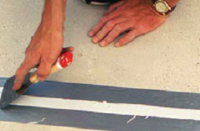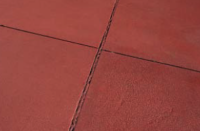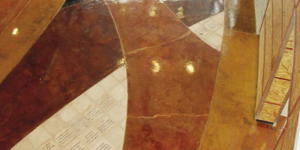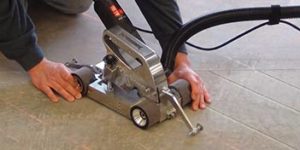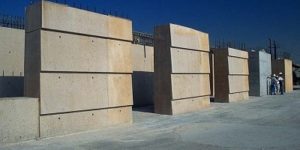It’s a game of inches.
That’s the cliché heard about baseball, and often about other sports as well. And why not? It’s a saying that rings true and also applies to decorative concrete and polished concrete, where precision matters down to the millimeter, let alone the inch.
A reminder of this reality came into sharp focus for Surfacing Solutions Inc. of Temecula, California, during a polished-concrete project at the nondenominational Shepherd of the Hills Church in Porter Ranch, California, in greater Los Angeles.
Precision was the name of the game here, when attention turned to saw-cut artistry intended to create a mirror image of an interior saw-cut pattern in an adjacent exterior concrete slab in a design that artistically tied together both inside and outside. So precise, in fact, that the radial joints in the adjacent surfaces were designed to intersect where the interior surface met the exterior slab.
Sounds simple enough, but geometry is often complex. And when a professional surveyor does the geometry for one set of radial saw cuts, but isn’t on hand to calculate an adjoining set, the geometry can veer off course. Such was the case with a lobby area and an adjacent exterior concrete surface, elements of a glittering new auditorium building at the fast-growing megachurch. The lines did not meet as envisioned.
That’s where this reminder about precision hit home, say Surfacing Solutions CEO/technical adviser Shawn Halverson and chief operating officer and project manager Keith Cantillon. Surfacing Solutions completed staining and polishing the interior lobby area, but learned of the geometric miscalculation when the exterior flatwork was completed and the lines missed the mark.
What saw cuts?
Surfacing Solutions is an expert at repair work, and demonstrated with mockups that it could make the off-course saw cuts disappear with Spall-TX3, a high-strength polyurea repair material from Hi-Tech Systems. The owner of the Shepherd of the Hills Church agreed that the original saw cuts indeed were unseen by the naked eye in the repair mockup.
“We’re proud of our repair work,” says Cantillon. “It’s part of our expertise.” However, the owner was adamant that the surface be completely fixed — figuring he was paying for new, as-designed construction, not a repaired surface — and out came some 600 square feet of polished concrete.
“They knew they (the off-course saw cuts) were there, although they couldn’t see them,” Cantillon says.
The surface was demolished and repoured, given the required 28-day cure, polished to the original specifications and then completed with the properly positioned radial saw cuts.
The good news was that the general contractor split the cost of the re-do with Surfacing Solutions, the subcontractor, since representatives of both companies had a hand in plotting the off-line saw cuts. And costly it was, as the concrete was structural and not just decorative.
“We’re not sure why the surveyor wasn’t there,” Cantillon says. “And that’s probably the main reason for the mistake.”
“It did turn out to be a very nice job,” Halverson says. “One of our biggest takeaways is the importance of cooperation of the general contractor and the subcontractor — the two entities worked together to solve a problem.”
Choreographing the polish
Geometry aside, Surfacing Solutions delivered stunning, shimmering polished concrete floors in 35,000 square feet of lobby, worship sanctuary, cafeteria and stage areas, in a multicolored palette of caramel, chocolate brown and black. Precision techniques were employed to produce saw cuts that separated areas of different colors, stained using SureLock Concrete Dye from Ameripolish.
As for turning design into finished artistry, Surfacing Solutions might well have been choreographing a Broadway musical, what with the dance moves required to dodge other trades on the way to a triumphant curtain call.
The show was sketched out with the church and the GC in a series of discussions of design, color and technical issues. Design considerations centered on harmony with elements of the overall building themes.
“We put a lot of thought into how this would look,” says Halverson. Functionality also figured prominently, along with technical issues such as whether decorative radius cuts might interact with structural joints and create weak points in the concrete surface.
Various color choices were evaluated by the owner, with mockups created in portions of the building where the concrete floors would be carpeted over.
The project was divided into 10 phases, with each phase going through the complete polishing process — grind with 80-grit metal-bond diamonds, saw cut, polish with 100, 200 and 400 resin-bond diamonds, then stain, densify and apply guard. The polishing system used was from Ameripolish.
During the job, the crew might complete substantial square footage in the cafeteria, then jump to a portion of the lobby to make way for another trade to do their thing. This jigsaw-puzzle process required the Surfacing Solutions crew to “fade out” with color application as the work approached the border where a designated phase adjoined another section to be done later. This ensured the two sections would eventually blend together in shade and intensity of color.
Cantillon worked with the GC to determine the sequence and dimensions of various sections.
Going with the flow
Such “job-flow” challenges are more the norm than the exception for decorative concrete projects in new construction, say Halverson and Cantillon. The ideal scenario of a wide-open expanse of concrete floor with no obstructions or interruptions lurking doesn’t appear regularly in the real world.
“It never happens that way,” Cantillon says.
The project fit this model. “On a tight schedule, it’s hard to get the whole floor” to process. The crew would complete a section, put up caution tape and turn the space over to the next trade, Cantillon says.
“The (general) contractor worked pretty hard with other trades to avoid damage, but there were areas we had to go back in to repair.”
But that’s life in the trade: In the age of fast-track construction, it’s a logistical chessboard in a complex production that demands choreographed sequencing.
While we’re spouting analogies, don’t forget that sports mantra about the game of inches — or more accurately in the precision-demanding decorative concrete trade, make that millimeters.
Project at a Glance
Client: Shepherd of the Hills Church, Porter Ranch, California
Decorative concrete contractor: Surfacing Solutions Inc., Temecula, California | www.surfacingsolutionsinc.com
Concrete contractor: GBC, Lake Elsinore, California
General contractor: Visioneering Studios, Irvine, California
Scope of project: Joint saw cutting, staining and polishing 35,000 square feet of interior concrete surface in new church building, in lobby, worship sanctuary, cafeteria and stage areas.
Most challenging aspect: Formulation of color combination in discussions with owner; managing logistical complexities due to activities of several other trades; planning and sequencing 10 different phases of project; color matching surfaces stained and polished in different phases; and redoing 600 square feet of polished concrete because of wrongly placed saw cuts.
Products used: Ameripolish concrete polishing system: 3D HS densifier, SureLock concrete dyes and 3D SP Stain Protector; Diamatic grinders and Procrete Resources diamonds.
